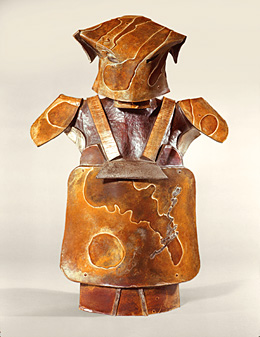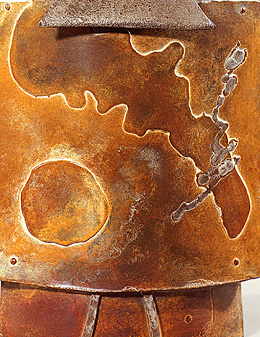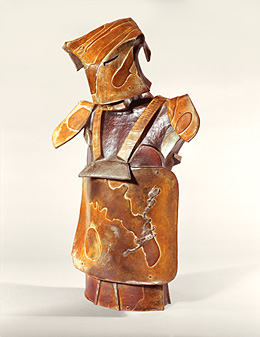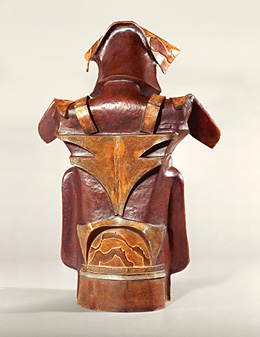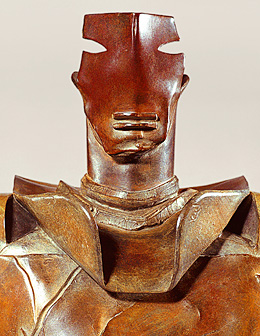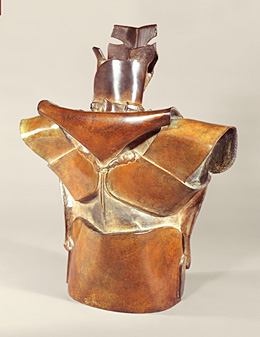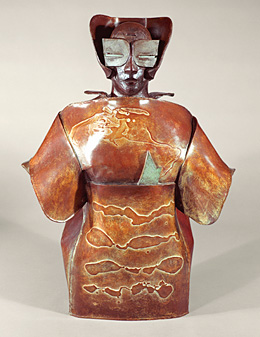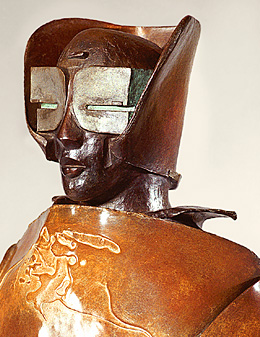|
|
|
|
|
|
|
|
|
|
|
|
||||||||
Plaza Art 92
|
||||||||
THE CRUCIBLE AS VOLCANO Let’s be clear about one thing: sculpture’s a messy business. True, modeling wax or clay can have a quiet delicacy of movement but it often yields to the sheer gusto of push, pull and squeeze, often as wrenching as a sweaty wrestler looking for the perfect lock. In a sculptor’s search for perfection of form at some point those of us who choose bronze must enter the even grittier world of the foundry. And what a noisy place it is. When grinding metal I wear not only earplugs but a cap and earphones as well. All around you hammers pound, tools whine, welding sparks spit and hiss but none of this really prepares you for the roar of the gas jets. The thunder is continuous and the molten bronze with its orange glow is no different than a spill of lava rushing to the sea. It’s the primal majesty of the crucible as volcano. The appeal of metal has to it the grandeur of Genesis and the beginning of time. The birth of the planet in the form of continents and mountain ranges is sculptural. The land is as much the measure of Man as the body is a house for the soul. People ask me where my sculptures come from: I like to say they emerge. One of my favorite words is stratum. It has both geological and archaeological connotations. It’s a word I like to apply to my own work: layers of meaning, layers of inspiration and layers of accomplishment. A successful sculpture should invite more than one visit. Its secrets need to be peeled away. It takes time and engagement. I have a body of work called Inner Sanctum. If that implies a journey, it’s meant to. And to get there, the Inner Sanctum, you will need some vigilance as I have put a variety of imposing guardians in your way. And they will ask you what you ask of them: are you friend or foe? Yes, this is theater. The mind is forever testing itself. I believe the best art is reciprocal. It makes you work too. Consider my sculpture EMISSARY with its formal robes and mysterious goggles. The message is tucked in a packet in the waistband and not revealed by the eyes. Even its sexual identity is not clear: Is it a she? Is it a he? And the message itself: is it for you or is it for me? The sculpture MANDRAKE on the other hand is very much the rugged bodyguard. Make him your friend and he’s there to protect you from the demons that lurk in our own difficult times. Where did I get the name MANDRAKE? I’m not sure. I expect I heard it somewhere and liked the music of the word. I know I started calling the piece MANDRAKE before I ever thought of looking it up in the dictionary. And when I did, I was surprised to find the following: “an Old World herb of the nightshade group with a large forked root superstitiously credited with human and medicinal attributes.” Look at Mandrake’s mask. Look at the way the eye sockets are cut and slightly raked, recalling a fork. Medicinal? When I nearly died from pneumonia after a running accident, did he save my life? Was he there by the bed? I was in a coma so I really don’t know, but I’m grateful for his presence. In retrospect my first bronzes were clumsy and naïve. They owed their inspiration to my investigation of ancient Greek bronzes and the sculpture of the Italian Renaissance. As a Cambridge student of history I visited museums all over Europe. As a child in Minnesota I was fascinated by the Native American art and the Mayan art that I saw at the St. Paul Science Museum. My move to San Francisco brought me into closer contact with Asian cultures. My web of cultural influences was also widened by the outstanding shows of African and Oceanic Art that I saw season after season at the James Willis Gallery on Geary Street. This was an artist’s baptism by immersion. I like to let people know that I consider myself part of a great tradition. Whatever poetic license I take, or whatever rebellions of form and content that I engage, they all are informed by an eager and profound study of the past. It nourishes me and perhaps that’s why people find my work “timeless”. Of course only time will tell. MANDRAKE, like all my guardians, has many predecessors. Its slab construction recalls the Haniwa warriors of ancient Japan. The only difference is that I used wax sheets and toothpicks instead of clay. It stood guard in my apartment for two years before I decided to have a mold made for casting. That was 1983. Disaster! The mold-maker had no idea the pressure of the rubber poured inside the mold would crush the hollow wax inside. She sadly called me to come by and collect the pieces. Once again that word, reciprocity! If MANDRAKE had in his way saved me, I was determined to save him. Like a surgeon I carefully reconstructed the pieces around a new but solid core. When it came time to attach the big breastplate I hesitated. It was now in two pieces and they no longer neatly fit together. It had an irregular fissure that reminded me of a winding river canyon. I told myself, keep the fissure. Hadn’t I selected this wax sheet in the first place because its surface reminded me of a lunar landscape? Don’t landscapes evolve and change? Don’t rivers erode and carve channels into the soil, and don’t channels deepen into canyons? So I left it as documentary evidence of this sculpture’s history, as prominent as any of the scars that cut across my forehead and abdomen. The spontaneous in my experience should be a welcome element of design, but then I’m one to turn a disadvantage into an advantage. In 1982 a winter monsoon hit the San Francisco Bay area. One torrential downpour lasted 36 hours without interruption. I couldn’t leave my studio apartment. The weather held me captive but I was also mesmerized by the wind and pounding rain. But it was not all music as the news reported mudslides devouring homes. Forty lives were lost. I’m asked if I’m ever influenced by movies. I say, “Absolutely!” I’m very conscious of any costumes and sets that serve a compelling story line. My sculpture STORM LORD may have been on one level, or stratum, an immediate response to the severe weather outside my windows. I’d call that looking out of myself, but on another level, or stratum, by looking into myself I recalled a scene from an epic by Sergei Eisenstein called “Alexander Nevsky.” The scene that came to mind was the charge of the Teutonic Knights in full armor across a lake of frozen ice. The ice collapsed under the weight of the horses and armor, however, it was the helmets, poised for assault, which gave me the idea for an anthropomorphic interpretation of a storm coming as a medieval knight. With that vision in mind I cut the armor from wax sheets that I had deliberately splashed and dribbled with more wax. The texture of the relief is flat and shallow as might be found in Japanese lacquer ware. For the helmet I chose sheets that reminded me of a crowded pattern of clouds. For the breastplate I chose another sheet embellished by an elemental sun, thunderhead and lightning bolt. The patina is colorful, to say the least, but it’s meant to serve a compelling story line. One footnote, and that’s really just what it is, as I like to smooth an area inside my bronzes so I can leave an inscription. Sometimes I have only room for my name, the date and title. In the case of STORM LORD I had enough room to include a poem that I’ve composed. I call such poems “archaeological teases.” Why? Some day, digging down to our stratum, the far future will find not only a sculpture by me, but also a message, IN THE VIVID RAIN I go out to those still standing, I admire the solemnity of the patient And the terrible dread of emptiness. Jack Frost has grabbed their shoulders. When the hellcat jumps, moves its paws Stonemasons on the Cathedral scaffolding And its assault on their will. When the fog mounts and the colors change. Blithe as swans. Finally— Poem by Roger Arvid Anderson |
|
|||||||
